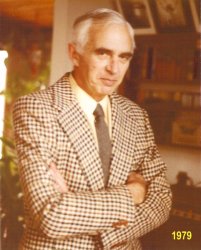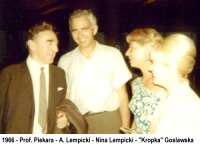 |
ALEXANDER ADAM LEMPICKI. PhD Polish patriot, renowned physicist - in Memoriam |
Bill Biega's Essays, |
|
Click on any illustration with colored border to see it full size. Then click on "Back" button to return to this page.
From 1934 till 1939 Lempicki was a high school student in the renowned boarding school Liceum Sułkowski in Rydzyna, western Poland. It was here that he demonstrated his talent for physics, and under the mentorship of the physics teacher Dr.Arkadiusz Piekara , carried out many advanced investigative projects, including studies of cosmic rays. Unfortunately the invasion of Poland by the Nazi armies forced a six year break in his studies. He completed his Matriculation examinations in secret study groups in Warsaw in 1941 (the occupiers had closed all secondary schools).
In January 1945 the Soviet army advanced through central Poland. Although named by some as "liberators", they were accompanied by the NKWD, and its Polish branch UB (Urząd Bezpiecze&$324;nstwa), which continued the Nazi terror tactics of arresting, and frequently executing, families of the landed gentry and members of the Polish Underground that had been fighting the Nazis for so many years. Alexander was arrested in March 1945 and incarcerated in the prison in Ostrowiec Świętokrzyski. Fortunately he and a number of other prisoners were used in work parties to repair the railroad. He took advantage of being marched through a farmers market to make his escape. He reached the apartment of Dr. Piekara in Kraków, where he hid while preparing documentation to escape Poland. He made his way through Czechoslovakia to reach the American Third Army in Pilsno. From there he reached the Polish Second Corps of General Anders in Italy, in July 1945. |
|
||||||||
|
He used his knowledge of the escape route to
organise the bringing of families of officers from Poland to Italy. In fact,
he personally returned to Poland to escort the wife of one senior officer to
Ancona. He then enrolled in the university in Rome to study physics. However in
1946 the Second Corps was moved from Italy to Great Britain for demobilisation.
He was enchanted by the friendliness and openess of
his colleagues and neighbors, the assistance that was so easily available to
him in finding a place to live, in buying a used car, and establishing a new
life. He noted how his colleagues were proud of the fact that their parents had
been poor and had worked at menial jobs, this was markedly in contrast to the
caste system prevalent in Europe and which he personally deplored, probably
influenced by the philosophy taught at high school in Rydzyna.
In 1983 he
received an appointment as Research Professor at Boston University, where he
continued research in the chemistry and physics laboratories on laser materials,
optical properties of ceramics and light scattering in solids. In 1989 he
established his own research company - ALEM Associates - to apply his knowledge
to solving practical problems, and with the assistance of Prof. C. Brecher the
development of new scintillator materials and optical ceramics, in particular
for application in Positron Emission Tomography (PET Imaging). This work was
supported by grants from NIH (National Institute of Health) and SBIR (Small
Business Innovation Research ) grants from DOD.
Dr. Lempicki has written or co-authored over 180 papers, and has obtained 20 patents. After the de-Stalinization of communist Poland. he resumed close contact with Dr. Arkadiusz Piekara until his death in 1989, and also with the University of Torun and has provided work assignments at ALEM for many students of that university, assisting them in obtaining their PhD degree.
Alexander Lempicki was not only a dedicated and extremely talented scientist. He
also maintained a lively interest in cultural and outdoor life, he and Nina
decorated their homes with art objects acquired all over the world, including
several pictures and sculptures by his great-grandfather (on his mother's side)
Piotr
Michałowski. For a number of years Alik maintained a dark room in which
he worked on his own photographs. While still living on Long Island, he and Nina
had bought acreage in the Berkshires where for many years they kept horses. They
adopted two girls in the 1960s - Maria and Veronica. After moving to Boston
University they built a lovely house in a western suburb of Boston. but when
Nina's health started failing, they sold it and moved to a townhouse on
Commonwealth Avenue in Boston. Nina died in 1999 after a long fight with
Alzheimer's disease.
Sources:
|
|||||||||
|
|
|||||||||
|
Return to Top of page.
Last update February 2008 |
|||||||||

 During the German occupation he was a very active member of the Polish Underground movement. Initially he was a
courier distributing newssheets around Warsaw with the latest news obtained from BBC broadcasts.
During the German occupation he was a very active member of the Polish Underground movement. Initially he was a
courier distributing newssheets around Warsaw with the latest news obtained from BBC broadcasts.
